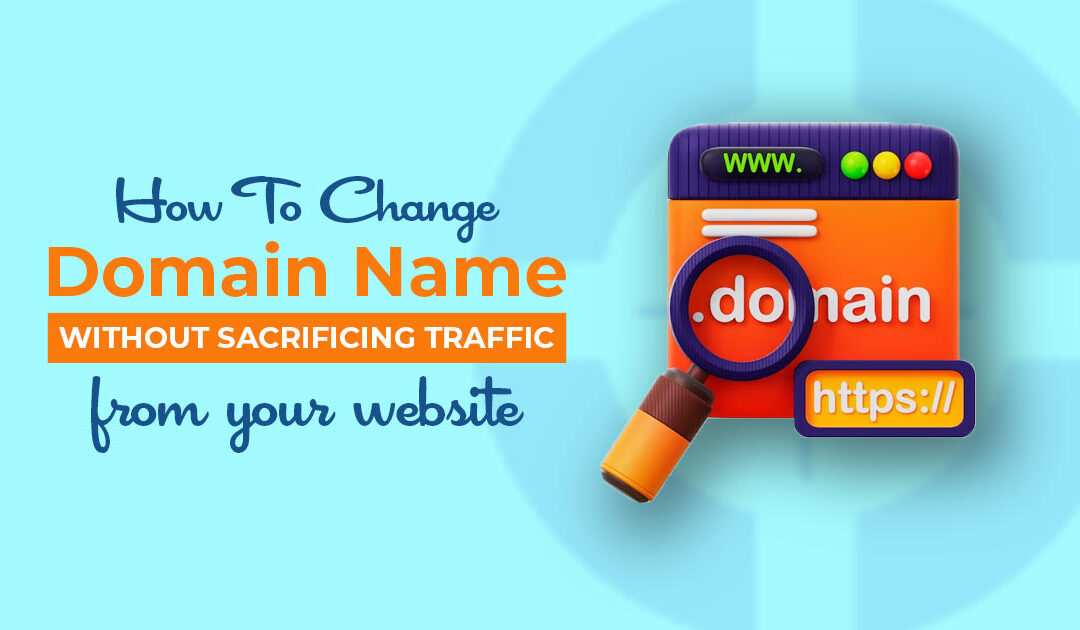Whether you’re an owner of a small business, a big enterprise, or a freelancer, the chances are that you have to learn how to handle your site by doing. This is quite effective in many ways, possibly if you exclude rocket science. While learning new things, you probably asked yourself, “Can I change my website’s domain name?” You would be glad to know that the answer is YES!
Although this “learn as you go” strategy can help you advance technically, it may have occasional drawbacks. Changing your website’s entire domain, URLs, and the history of all associated organic traffic from your website might not be the ideal area to “wing it.” There is a risk of causing significant harm to your online reputation.
Fortunately, you can change your domain name without sacrificing traffic from your website. Doing so won’t negatively affect your SEO in the long term. So, in this article, we will uncover a few reasons to change your website’s domain name. Then we will talk about how to change your domain name without affecting the visibility and traffic of your website.
Common Reasons to Change Your Domain Name
Choosing a domain name is a crucial decision for many website owners. While some may be fortunate and select a domain that lasts forever, it is likely that your domain name will eventually need to be changed. Here are a few possible reasons why business owners change their domain names:
Relocation: Relocating might not be a big deal if you have an online store. If the name of your domain is a country code Top-Level Domain (ccTLD) like .ca, .us, or .eu, you might need to change your domain to avoid confusion.
Rebranding: Most top online businesses will either shift or change for the best chances of success in the cutthroat e-commerce market. To reflect the new image of your website, you might need to adjust your domain name. Another reason may be fewer results for your domain name search.
Growth: To expand your business further, your small business needs to change its domain. For instance, you might need to alter your domain name to something more generic if it is too specialized.
Copyright Issues: Even the sincerest businesspersons or entrepreneurs can make a mistake. If you learn that your domain name violates someone else’s intellectual property, you should probably change it to avoid any legal actions.
These are just a few instances where you might need to register a new domain name. However, there could be other reasons. For example, you might have been looking for your desired domain that just became available. It is okay to change your domain just because you found a better one.
10 Steps to Change Domain Name Without Affecting SEO
Now that we have learned the most common reasons to change domain names, you must wonder if there’s a way to do it without affecting the SEO. So, we have prepared 10 steps that will let you change your domain name without jeopardizing the visibility of your website. These steps are:
Step #1: Select a Domain Name
First things first, you need to find a good domain name. Your domain name should be easy to type, pronounce, and spell. If your domain name is easy to remember and you offer quality services, it will encourage your customers to talk about your business. As a result, you can get free “word-of-mouth” publicity. Once you decide on a domain name, don’t waste time and buy it.
Step #2: Audit Your Backlinks
After deciding on a domain name, you aren’t quite ready to make any changes yet. So, before you migrate to your new domain name, you are advised to analyze all backlinks you have online that direct to your old domain before you make any changes.
It will help you keep track of every one of the locations where your old site is mentioned so you can refer to them later and redirect your website URL.
Step #3: Move Your Site to New Domain
Congratulations! You have finally purchased your new domain, conducted backlink auditing, and now it’s time to transfer your old website to the new domain. This process could be quite tricky as transferring websites involves moving all files and databases, which also varies depending on your domain host provider.
Step #4: Update 301 Redirect
A 301 redirect not only points readers to the correct page but also lets search engines know that it has been permanently moved. You can build a “wild card” redirect in your—htaccess file to relocate anything at the domain-name level. Adding a 301 redirect to every URL on your old site will lead visitors to the new domain’s URL instead of the old one. This is crucial for both search and traffic, so take your time and double-check that everything is 301 appropriately redirected.
Step #5: Crawl the Website
To ensure that the 301 redirects have been set effectively and to look for any technical SEO concerns, crawl the new website using Web Crawling Tools. Redirect chains, 404 errors, and improper canonical tags are common problems during domain change.
Step #6: Google Search Console Setup
You must create and validate a new Search Console account for the unique domain while changing your domain. This is crucial from SEO perspective.
Step #7: Submit Sitemap
Submit a sitemap for your new domain when your new Google Search Console account is created. In doing so, Google will be able to crawl the new website successfully.
Step #8: Submit Address Change
In Google Search Console, an address change request is made to inform Google that your old domain has been moved to your new domain. To achieve this, you must own both the old and new domains’ Search Console accounts.
Once you have set your 301 redirects, visit the search console account to get the old domain name.
Click Settings > Choose the Domain Account > Update & Verify
Step #9: Set Up Google Analytics
You must create new Google Analytics, Tag Manager, and Search Console accounts and reset any tracking and filters in your old account after switching to your new domain.
Step #10: Monitor Results
Every time you make a significant change in SEO, like switching to a new domain, you want to pay closer attention to important insights like fluctuation in website traffic, ranking, etc. You can do so using both Google Search Console and Google Analytics.
Conclusion
Changing your domain name doesn’t have to be an overwhelming task. You may smoothly switch to your new domain and keep expanding your online presence without harming the SEO of your site. You just need to take the required precautions and be aware of the effects on your SEO and site visitors.
If you feel that migrating to a new domain is a daunting task, you can always seek help from SEO Consultants. The experienced team at Search Engine Consultants will make all the necessary changes without harming your SEO.


